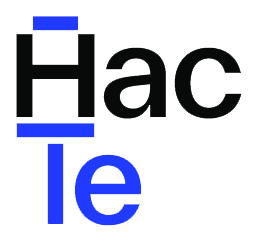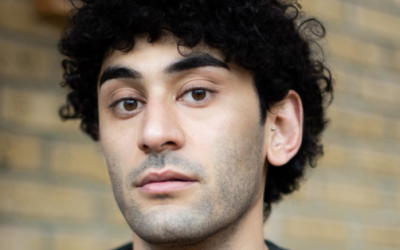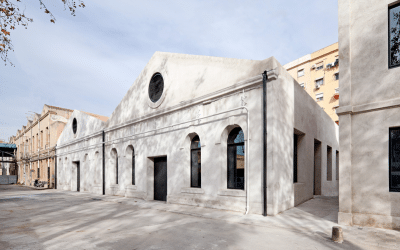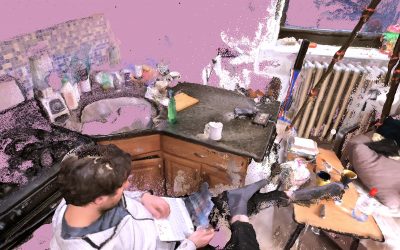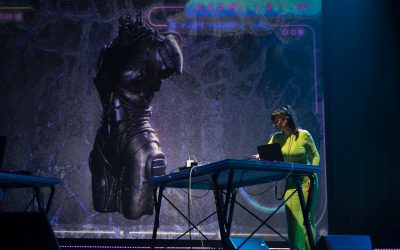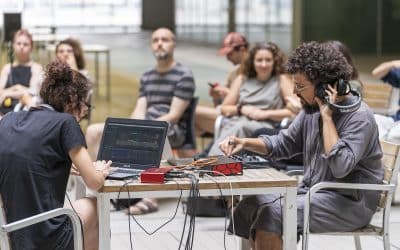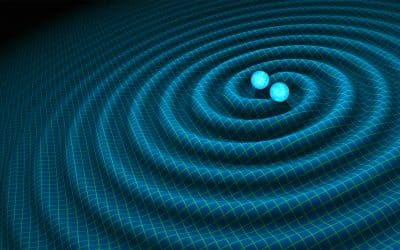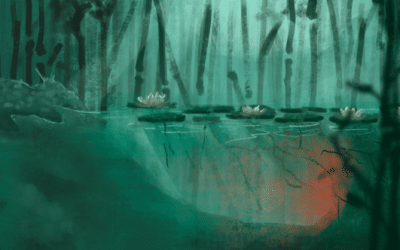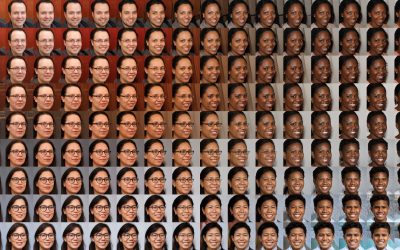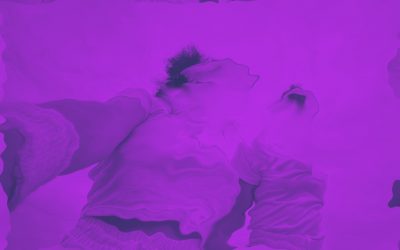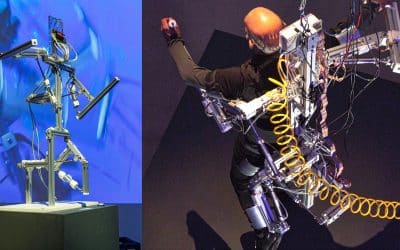
Upcoming activities
Taller amb Elisa Giardina Papa i Zach Blas
HacTe, juntament amb els seus membres Hangar i einaidea, organitza un taller intensiu de tres jornades amb lxs artistes Elisa Giardina Papa i Zach Blas. El taller s’impartirà en anglès entre els dies 5 i 7 de setembre, i reflexionarà sobre els modes actuals d’automatització digital del coneixement, les emocions i processos creatius, així com les formes de resistència, pertorbació i qüestionament que poden emergir des de les pràctiques artístiques. Dues sessions de mitja jornada de treball donaran lloc, el tercer dia, a un esdeveniment públic de posada en comú, presentació de pràctiques i taula rodona a Hangar.
Zach Blas (West Virginia, els EUA, 1981) és artista, cineasta i escriptor. La seva pràctica aborda la materialitat de les tecnologies digitals a través del vídeo, la computació, la teoria, la performance i la ciència-ficció. Les seves obres investiguen les filosofies i els imaginaris que aguaiten en la intel·ligència artificial, el reconeixement biomètric, la vigilància predictiva, la seguretat aeroportuària, Internet i la guerra biològica. Ha participat en exposicions i conferències en Tate Modern (Londres); Walker Art Center (Minneapolis); la Biennal de Gwangju; Berlinale (Berlín); Escorxador (Madrid) i ZKM (Karlsruhe), entre altres.
Elisa Giardina Papa (Medicina, Itàlia, 1979) és una artista que investiga el gènere, la sexualitat i el treball en relació amb el capitalisme neoliberal i les fronteres del Sud Global. El seu treball ha estat exposat en la 59a Biennale di Venezia; MoMA’s Modern Mondays (Nova York); el Museu Whitney (Nova York); Seoul Mediacity Biennale 2018; XVI Quadriennale di Roma; Flaherty (Nova York); UnionDocs (Nova York) i ICA Milan, entre altres. Ha donat conferències en el Pembroke Center for Teaching and Research on Women (Brown University), el Institute for Gender, Sexuality and Feminist Studies (McGill University), i el Global Emergent Mitjana Lab (Concòrdia University), entre altres.
Aquest taller és gratuït i obert, amb inscripció prèvia. Si t’interessa, envia un breu paràgraf de motivació abans del dia 1 de setembre a antonio@hangar.org
Amb el suport del Departament de Cultura de la Generalitat de Catalunya
Previous activities
Xerrada de Mark Farid a Sobtec. VI Congrés de Sobirania Tecnològica
Mark Farid, artist in residence at the Universitat Oberta de Catalunya (UOC) as part of the S+T+ARTS in the City programme, will participate as a speaker at Sobtec, VI Congrés de Sobirania Tecnològica. During the event, which will take place at Hangar next March 2, Farid will present his project ‘Invisible Voice’ (IV), a platform that reveals the power structures and business practices behind the websites we interact with. The project seeks to leverage our collective action to bring about meaningful change through the empowerment of data.
The talk will be in English.
Workshop by Matthew Fuller: Art as Metadiscipline
In recent decades artists have increasingly worked on the problems and the modes of enquiry of other disciplines and fields. The findings, styles of thought, and habits of operation and conduct of the sciences, sociology, mathematics, literature, governance and education, amongst others, have become resources for reworking and expanding. They are used to probe questions of power, imagination and invention. This condition has multiple roots. Some are quantitative, due to the expansion of art schools and the sheer volume of people trained and prompted to rework ideas in a reflexive manner characteristic of contemporary art. Others are to do with the changing terrain of post-conceptual art and its multiple tendencies, including what is discussed as research. Some of this includes an engagement with sciences and the adoption and alteration of their working methods. Such work includes approaches ranging from treating disciplines and their objects as “found objects” or of elaborating techniques of mutual interest. Others rework the idea of art into a process of learning and becoming in education or in forms of political and ecological direct action or speculation and also, uniquely to art, a mobilisation of what is rejected or expelled by disciplines.
These tendencies suggest that art is fragmentarily emerging as something that might be called a meta-discipline: a mode of work whose operation includes both working in other disciplines and to act upon them. Mathematics and philosophy have been key meta-disciplines for a long period. They work in and on both the conditions of possibility and the working matters of other fields.
Art has historically been allocated the role of working on sensation and feeling via representation. In the present, art also works on concepts, institutions, techniques and information, including the workings of these prior-metadisciplines. This workshop will examine aspects of the genealogy and potential of this tendency. The workshop will consist of an introductory talk and then a mapping exercise, all artists, curators, organisers and anyone interested are very welcome.
Xerrada performativa ‘The Smallest of Worlds’, amb Uwe Brunner, Bettina Katja Lange i Joan Soler-Adillon
This activity is part of the program Oasi, within the exhibition Digital Impact
Oscillating between the physical and the virtual dimension, The Smallest of Worlds
(2021) and #See You at Home (2022) explore the meaning of private and intimate space
in times of ubiquitous connectivity, examining home in its dual relationship between safe
shelter and a platform for public exhibition.
This lecture performance will delve into the archive of these two artworks, which is made
up of a multitude of digitized private spaces, with its narrative, intimate routines, and
personal memories: fragments that were collected in more than 40 countries during the
most intense periods of self-isolation during the pandemic.
Showing the archive from a new perspective, custom made for Digital Impact’s immersive
space, the artists will discuss the implications of the ways our perceptions of such private and
intimate spaces radically changed during this intense period, and are now being reconfigured
to achieve new meanings in a hybrid context where our online and offline presence is
ever more entangled.
Since 2020, Uwe Brunner, Bettina Katja Lange and Joan Soler-Adillon have worked
together to explore how immersive experience can offer new and unique narratives.
Their work has been shown in major European XR and documentary festivals in Europe
and around the world. Now, for the first time, the immersive experience leaves behind
single-person headsets and standard screens to be experienced collectively in a
large-scale projection space.
Language: Catalan and English
Conversa/demo sobre Intel·ligència artificial i música, amb AWWZ, UPC i Sónar
Foto: AWWZ b2b AI / Klamer Hernandez
La intel·ligència artificial s’està convertint ràpidament en la medul·la digital de les nostres vides, amb un impacte en totes les facetes de l’entreteniment, la cultura i la comunicació. Impulsat al 2021 per Sónar, la UPC i betevé, l’AI and Music S+T+ARTS Festival va explorar el rol d’aquestes noves tecnologies en les nostres vides prenent la música com un exemple.
Una de les tres cocreacions d’artistes i enginyers especialment creades pel Festival va estar AWWZ b2b AI Dj, fruit de la col·laboració entre la productora i dj AWWZ, i un equip d’investigadors de la UPC: Mireia de Gràcia, Casimiro Pio i Dimas Ávila.
En el marc de Digital Impact, aquest equip transdisciplinar ens explicarà com va estar aquest procés de cocreació on s’entrecreuen la classificació de gèneres amb intel·ligència artificial i la performance. Durant la xerrada es presentarà aquesta IA especialment entrenada que tradueix els comentaris de Youtube en suggeriments de cançons i AWWZ ens en farà una petita demo del seu funcionament.
Participa:
- AWWZ (Gemma), dj i productora
- Mireia de Gràcia, enginyera de telecomunicacions especialista en so i computació musical i dj
- Antònia Folguera, comissària de Sónar+D
Aquesta activitat forma part del programa Oasi, en el marc de l’exposició Digital Impact
Performance ‘Sons en Causa’, amb l’Orquestra del Caos
Aquesta activitat forma part del programa Oasi, en el marc de l’exposició Digital Impact
Sons en Causa és un projecte basat en un arxiu sobre el qual l’Orquestra del Caos treballa des del 2009. En creixement constant, l’arxiu de Sons a Causa conté preses d’alta qualitat de paisatge sonors realitzades per Carlos Gómez i Josep Manuel Berenguer al capdavant de diferents equips a la proximitat de llocs de Llatinoamèrica on les activitats humanes han experimentat un increment notable en èpoques recents. El mostreig acústic al llarg de trajectes entre les zones més afectades pel bullici humà i les més allunyades podria arribar a donar idea de com va ser el paisatge sonor en aquests contextos abans que la influència humana el transformés a mesura que les societats es feien cada cop més complexes.
Actualment recull 1700 preses d’àudio binaurals realitzades a Amèrica Llatina, a 24 bits de resolució, 48kHz de freqüència de mostreig i de 20 minuts de durada. La raó d’una tan llarga durada és el desenvolupament lent de l’evolució temporal del comportament de les fonts sonores al paisatge. No ens interessen els sons aïllats, sinó llurs relacions; llurs conflictes i llurs resolucions, que s’aprecien de manera gradual o sobtada i en relació amb els equilibris immediatament precedents. L’escolta atenta i profunda del batec del món és molt gratificant. Proporciona un gaudi estètic considerable d’evident interès per a nosaltres, artistes i músics; però el registre sonor no és únicament una qüestió d’abast estètic, així que, malgrat la nostra tendència a valorar els aspectes formals, els que més directament orienten les nostres accions i projectes, ens sentim profundament responsables de les seves implicacions més enllà del que és purament artístic. Estem convençuts que l ́escolta atenta del paisatge sonor és un element distingit de conscienciació sobre les necessitats socials d’un so saludable. D’aquesta manera neix la nostra orientació cap a la presa de so en contextos d’especial interès humà i social. Amb el temps, s’ha convertit en un esperó de primera magnitud. Ens orienta a la reflexió sobre els dominis de l’art i de la seva funció, sempre en redefinició.
Amb la participació de:
- Lina Bautista
- Josep Manuel Berenguer
- Matias Klenner
- Anna Gatz
- Ginebra Raventós de Volart
Xerrada ‘L’espai-temps, el material més rigid que coneixem’, amb Eugenio Coccia (IFAE)
L’espai-temps té les propietats d’un material. Es deforma i vibra com els materials que coneixem, però no n’hi ha cap de més rígid.
La teoria de la gravetat ens explica com la massa deforma l’espai temps i com es poden produir vibracions de l’espai-temps que viatgen pel cosmos. D’aquí surten els forats negres i les ones gravitacionals, fenòmens còsmics que ens permeten entendre el passat de l’Univers.
I si l’espai-temps no fos continu sino digital?. És una proposta que ens ajudaria a entre el més petit i el més gran en una sola teoria. Seguim investigant l’univers amb instruments cada cop més precisos per tal de descobrir si és així o no.
Xerrada/demo sobre escultura virtual, amb UPC
Aquesta activitat forma part del programa Oasi Digital, en el marc de l’exposició Digital Impact
En aquesta xerrada s’explicarà el procés de creació d’escultures digitals amb l’eina Tilt Brush, un pinzell virtual que permet pintar en un espai 3D en realitat virtual. La seva paleta pot incloure textures tan variades com ara tinta o fum, neu o foc, explorant totes les possibilitats d’aquesta eina virtual de pintura en l’espai.
Aquest recull de peces que es presentaran ha estat confeccionat per l’alumnat de l’assignatura de realitat virtual del Grau d’animació i art digital del Centre de la Imatge i la Tecnologia Multimèdia de la Universitat Politècnica de Catalunya.
Crèdits dels projectes seleccionats:
City of Tears
- Daniel Anter Tolansk de Melo
- Judith Berenguer Guinovart
- Jazmin Catrea
- Oscar Cerezo Garcia
- Edurne Espes Rodriguez
Fantasy Scenario
- Nuria Roca
- Michela Vistarini
- Marçal Rossell
- Jana Moyes
- Judıth Estrada
A look in the Deep
- Leyre-Ying Paredes
- Cristina Gutierrez
- Victoria Castro
- Carla Asensio
- Claudia Dai
Anatomy Park
- Lois Navarro
- Sara Roig
- Blanca Perez
- Eric Olmo
Xerrada participativa ‘Ventrilòquia amb Intel·ligència Artificial’ amb Estampa
Aquesta activitat forma part del programa Oasi Digital, en el marc de l’exposició Digital Impact
Les eines d’intel·ligència artificial aplicades a la imatge han evolucionat molt durant els últims deu anys. Avui, són un mitjà capaç tant de canviar-te l’aspecte de la cara a les xarxes socials, com de fer-te dir coses que no recordes haver dit mai. Si entenem com funcionen aquestes eines, aprenem a entrenar-nos en la sana habilitat de sospitar de les imatges, però, i si ens ho mirem per la banda creativa? En quines situacions ens agradaria veure el nostre doble digital? Quines possibilitats tenim a l’hora d’imaginar doblatges impossibles? Quins dibuixos ens agradaria que parlessin dels nostres problemes? Podem intervenir en les obres d’art més icòniques?
El pròxim 7 de juny, el col·lectiu Estampa oferirà una xerrada participativa on reflexionarà i posarà en pràctica les possibilitats creatives i les implicacions dels deepfakes, una tècnica d’intel·ligència artificial que permet produir vídeos de persones –anònimes o conegudes– parlant o duent a terme accions que no han passat mai.
Performance col·lectiva Òrbita #4, amb Núria Nia i Citlali Hernández
Aquesta activitat forma part del programa Oasi Digital, en el marc de l’exposició Digital Impact
Òrbita #4 és una performance col·lectiva on, a través d’instruccions bàsiques, es programa el llenguatge d’un bot. Mitjançant una posada en escena que hibrida la performance i el taller participatiu s’exploren les possibilitats temàtiques i textuals d’una nova personalitat digital. L’experiment de crear una narrativa digital col·laborativa entre les persones assistents a Òrbita #4, propicia la revelació dels codis i els entramats que conformen aquestes personalitats digitals capaces de formar discursos més o menys lògics sense perdre el rastre de la mà humana que l’ha entrenat per a la missió.
ÒRBITA #4 és la 5a de les ÒRBITES que Citlali Hernández i Núria Nia activen performativament centrant-se en els conceptes dels cossos digitals, la telepresència, la comunicació per satèl·lit i la representació del cos en 3D. Aquestes ÒRBITES neixen amb el projecte Cos Satel·lital que les artistes van desenvolupar el 2021 en el marc de la IV Beca Hangar-FBSabadell, i han estat presentades al Festival Loop, a Fabra i Coats al Festival ECOSS, a Lo Pati d’Amposta amb ISEA2022, a Hangar i a les Jornades Wikifem del Konvent. Òrbita #4 és de nova creació i serà vista per primera vegada en el marc de Digital Impact.
“Excess, Indifference and Absence: Alternative Anatomical Architectures”, keynote by STELARC
| Within Digital Impact’s Oasi programme, Stelarc offers a keynote speech that takes as its starting point the new concept of embodiment the digital world offers. In the artist’s own words: In the liminal spaces of proliferating Partial Life, Synthetic Life and Machine life, the body has become a floating signifier. An empty signifier. The body now is no body at all. Performing increasingly remotely online, presence becomes problematic. Presence is marked by a double absence. Or perhaps absence is marked by a double presence. We are neither all-here-now, nor there all-of-the-time, but partly here sometimes and partly somewhere else at other times.
We continuously slide between offline and online worlds, navigating from physical nano-scales to virtual non-places. The body increasingly inhabits abstract realms of the highly hypothetical and of streaming subjectivity. The digitial is not merely the realm of the digital. The dead, the brain-dead, the partially living, the yet to be born, the cryogenically preserved, the prosthetically augmented, synthetic live and artificial life, all now share a material and proximal existence. At a time that the body is threatened existentially by fatally being infected by biological viruses, what becomes apparent now is that the human species is confronted by the more pervasive ontological risk of being invaded by its digital entities and viral algorithms. The individual body achieves planetary escape velocity but the human can no longer achieve escape velocity from the machinic and digital realm. IMPORTANT: This activity will be in English |
Project in collaboration with NewArtFoundation and V2_ Lab for the Unstable Media
